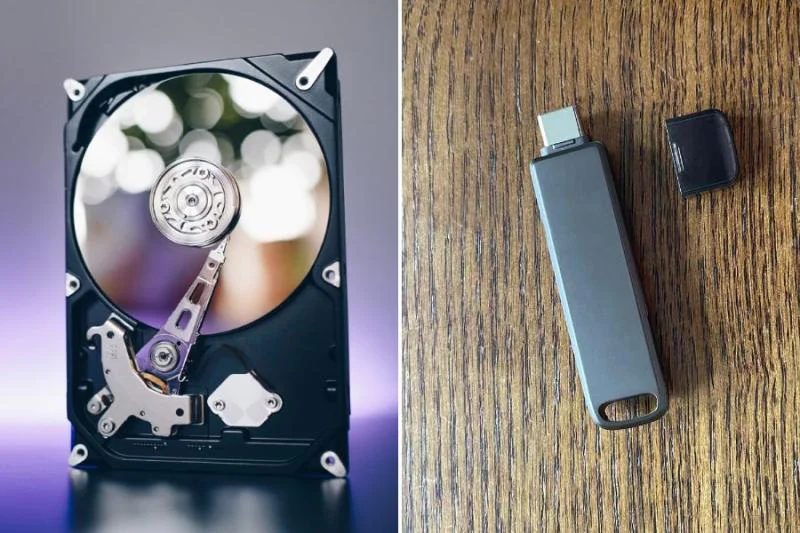Flash drives and hard drives are both types of storage devices, but they look and work differently. Flash drives use NAND-based flash memory, which is solid-state, light, and has no moving parts. This makes them easier to carry around and less likely to get broken. They are great at quickly transferring and accessing data, but because they can be written to and erased, they don’t last as long. On the other hand, hard drives use moving parts like read/write heads and magnetic disks. This makes them more likely to break. But they have more storage space and are cheaper per gigabyte, which makes them great for long-term storage and large amounts of data.
What is Flash Drive?
A flash drive, also called a USB drive, pen drive, or thumb drive, is a small, portable storage device that stores data using NAND-based flash memory. Flash drives have a Universal Serial Bus (USB) interface that lets them connect to computers and other devices. This makes it easy to move and access files across different platforms.
Flash drives are solid-state storage devices, meaning they have no moving parts. This makes them more resistant to physical damage and shock than traditional hard drives. The flash memory in these drives is a type of non-volatile storage, which means it keeps data even when the device is not connected to a power source.
The portable, lightweight, and plug-and-play nature of flash drives has increased their popularity. They are great for transporting files, backing up essential data, and quickly sharing documents, photos, and videos. But their storage capacity is usually less than that of hard drives and SSDs, and the number of write/erase cycles limits how long they can last.
Flash drives have gotten much faster since USB 3.0, and later versions came out. Because of these improvements, data transfer rates are now quicker, making flash drives more useful and easier to use. Even though they have these benefits, they are not recommended as primary storage for large amounts of data. Hard drives and SSDs are better for this.
What is Hard Drive?
A hard drive, also known as a hard disk drive (HDD), is a device used to store data. It is often found in computers and external enclosures. It uses magnetic storage to store and get digital information, like documents, photos, videos, and application data. Hard drives have one or more magnetically coated spinning disks, or platters, and read/write heads that move across the surface of the platters to access or change the data.
Compared to flash drives and solid-state drives (SSDs), hard drives have more storage space and cost less per gigabyte. This makes them perfect for long-term storage and large amounts of data. But the fact that they have moving parts makes them more likely to break and makes it take longer to access and send data.
Hard drives have changed over time in terms of how much space they can hold, how fast they work, and how they look. Advanced formats and technologies, like perpendicular magnetic recording (PMR) and shingled magnetic recording (SMR), have made it possible for storage density to keep growing. There are two main sizes: 2.5-inch drives for laptops and 3.5-inch drives for desktop computers.
Even though SSDs are slowly replacing hard drives in many applications because they are faster and last longer, hard drives are still a cost-effective choice for large-scale storage and backup solutions.
Difference Between Flash Drive and Hard Drive
Hard drives and flash drives are examples of data storage devices, but there are important distinctions between them in technology, design, and applications.
Storage Technology
Changing the magnetic fields on the platters is how data is accessed and modified in hard drives, which utilise magnetic storage in the form of rotating disks (platters) and read/write heads. Flash drives, on the other hand, employ NAND-based flash memory, a form of solid-state, non-volatile storage that keeps data via electrical charge even when disconnected from a power source.
Design and Durability
Flash drives are more resilient to physical damage and shock because they are small, lightweight, portable, and have no moving parts. Hard drives are more fragile than other types of data storage because they are mechanical and can break if subjected to shock, vibration, or extremes in temperature.
Performance
Data can be accessed and transferred quickly when using a flash drive with a USB 3.0 or later port. Because of their mechanical design, hard drives have lower data transmission and access speeds, but their higher cache capacities can sometimes make up the difference.
Storage Capacity
Compared to flash drives, hard drives often offer more outstanding storage capabilities at a lower cost per gigabyte. Hard drives are superior to flash drives for long-term storage and massive amounts of data.
Lifespan
Flash drives have a lower lifespan than hard disks due to their limited number of write/erase cycles. Even with careful handling, mechanical wear and damage are potential causes of hard disk failure.
Use Cases
Flash drives excel in being easily transported, transferring data rapidly, and serving as a short-term backup. However, when cost and capacity are at a premium, hard drives are the better choice for primary storage in computers, large-scale storage, and backup systems.
Simply said, hard drives and flash drives are not interchangeable in terms of storage technology, form factor, performance, capacity, lifespan, or recommended applications. Hard drives have bigger storage capacities and better long-term dependability than flash drives, while flash drives excel in mobility and speed.







